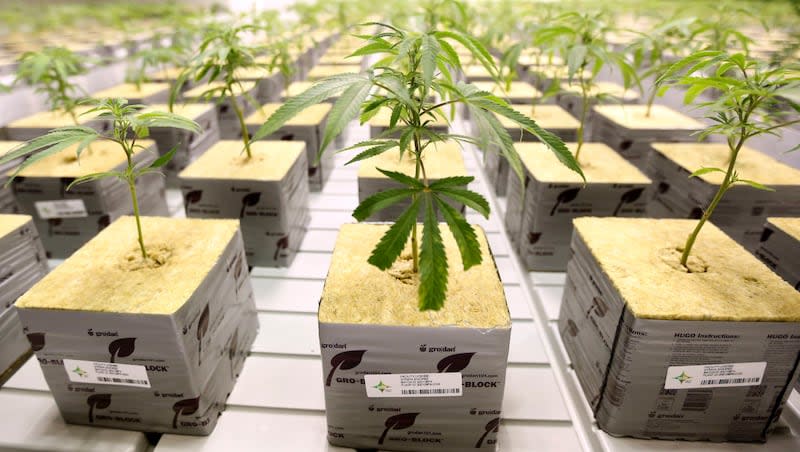DOJ takes major step toward reclassifying marijuana

- Oops!Something went wrong.Please try again later.
The Department of Justice took a significant step Thursday toward reclassifying marijuana as lower risk and less harmful, with President Joe Biden posting a video on social media saying no one should go to jail for using or possessing the drug.
“It’s an important move towards reversing long-standing inequities,” Biden said on X. “Far too many lives have been upended because of a failed approach to marijuana, and I’m committed to righting those wrongs. You have my word on it.”
The move, which Biden called “monumental,” would downgrade marijuana from its current classification as a Schedule I drug, which includes heroin and LSD, to a Schedule III drug, which includes ketamine and some anabolic steroids. The Biden administration has been signaling since 2022 that it would move to reschedule cannabis, which would for the first time acknowledge its medical benefits at the federal level.
Last summer, the Department of Health and Human Services recommended that the Drug Enforcement Administration reclassify cannabis under the Controlled Substances Act. The U.S. Food and Drug Administration also concluded that marijuana should be rescheduled, according to the Congressional Research Service.
Too many lives have been upended because of our failed approach to marijuana.
So today, the @TheJusticeDept is taking the next step to reclassify marijuana from a Schedule I to a Schedule III drug under federal law.
Here's what that means: pic.twitter.com/TMztSyyFYm— President Biden (@POTUS) May 16, 2024
What happens next?
The DEA submitted a notice of proposed rulemaking in the Federal Register on Thursday, triggering a 60-day public comment period before the rule is finalized, per NBC News.
During the first 30 days of the comment period, interested parties could request a hearing regarding the proposal. Under the law, the DEA would be required to hold a hearing before an administrative law judge, NBC News reported.
After the DEA reviews and considers the public comments, and at the conclusion of any requested hearing, the DEA will issue a final order to reschedule marijuana. The process could take from a few months to up to a year.
What is a Schedule I drug?
Under federal law, a Schedule I drug has no accepted medical use and a high potential for abuse. Drugs in that category include heroin, LSD, ecstasy, peyote and marijuana. Schedule III drugs, such as codeine, ketamine, anabolic steroids and testosterone, have a moderate to low potential for dependence.
Federal law still prohibits the possession of any amount of marijuana. Lowering the schedule would allow the use of medical cannabis but does not legalize marijuana. As a Schedule III drug, marijuana would remain regulated by the DEA, meaning the roughly 15,000 cannabis dispensaries in the U.S. would have to register with the DEA like regular pharmacies and meet strict reporting requirements.
Researchers, though, would face fewer restrictions if marijuana is rescheduled, which might lead to further studies.
Playing politics?
“Look folks, no one should be in jail for merely using or possessing marijuana. Period,” Biden said in the video.
Vice President Kamala Harris also posted a video on X about rescheduling cannabis.
“Currently marijuana is classified on the same level as heroin and more dangerous than fentanyl. We are finally changing that,” she said. “We are on the road to getting it done.”
Kevin Sabet, president of Smart Approaches to Marijuana, told NBC News that while the reclassification wouldn’t legalize the drug, it would “super size” the marijuana industry. He said it’s not good for public health and “reeks of electoral politics.”
“It’s become undeniable that politics, not science, is driving this decision and has been since the very beginning. This decision won’t legalize marijuana, and it won’t release anyone from prison or jail,” Sabet said. “This is setting the stage to create the Big Tobacco of our time.”
Utah GOP Sen. Mitt Romney and other Republican senators raised concerns in March about the Biden administration’s plan to reclassify marijuana.
“Any effort to reschedule marijuana must be based on proven facts and scientific evidence — not the favored policy of a particular administration — and account for our treaty obligations,” the senators wrote, citing the DEA’s duty to ensure compliance with the Single Convention on Narcotic Drugs, ratified by the Senate in 1967.
Marijuana is controlled under the treaty, the letter points out, “which is not surprising given its known dangers and health risks — and the United Nations’ International Narcotics Control Board (INCB) has fiercely criticized efforts to legalize marijuana in other countries as a violation of the treaty.”
President Biden and I vowed to address injustices in marijuana policy.
Today, our Administration takes another major step forward. pic.twitter.com/GxFOFeU0DU— Vice President Kamala Harris (@VP) May 16, 2024
Is marijuana legal in Utah?
Utah legalized medical cannabis in 2018 but recreational use remains against the law. The first state-licensed pharmacy opened in March 2020. There are now at least a dozen cannabis pharmacies in the state, mostly along the Wasatch Front. Eight marijuana farms and supply facilities manufacture, package and label cannabis products.
In Utah, all cannabis sold as medicine must be grown and processed in the state. All plants and products must be tested using random samples selected by the inspectors at the independent or state-run lab. Utah is unique in that the testing labs are not tied to the companies that sell the product.
As of last September, there were 72,296 medical cannabis card holders with active status in the state — an increase of 27% over the previous year, according to the Utah Department of Health and Human Services. The state had registered 964 qualified medical providers who can prescribe cannabis, a 13% increase from the year before. Those numbers change monthly as people and providers join or drop out of the program. The most recent data in April showed 86,335 patients and 955 qualified providers.

